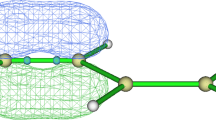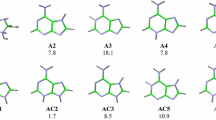Abstract
Structures and electronic excitation energies of the benzophenone–water (Bp–H2O) and benzophenone–methanol (Bp–CH3OH) complexes have been investigated by means of density functional theory calculations. The CAM-B3LYP/6-311++G(d,p) and higher level calculations were carried out for the system. The calculations indicate that free Bp has a nonplanar structure with twist angle of 54.2° for two phenyl rings (referred to as ϕ). In the case of the Bp–H2O system, the twist angle of the phenyl rings and structure of the Bp skeleton were hardly changed by hydration (ϕ = 55.1° for Bp–H2O). However, the excitation energies of Bp were drastically changed by this solvation. The time-dependent density functional calculations show that the n–π* transition (S1 state) is blue-shifted by the solvation, whereas two π–π* transitions (S2 and S3) were red-shifted. The origin of the specific spectral shifts is discussed on the basis of the theoretical results.







Similar content being viewed by others
References
Palma, A., Pasquarello, A., Car, R.: First-principles electronic structure study of Ti–PTCDA contacts. Phys. Rev. B 65, 155314 (2002)
Azuma, Y., Iwasaki, K., Kurihara, T., Okudaira, K.K., Ueno, N.: Low energy electron diffraction of the system In-[perylene-3,4,9,10-tetracarboxylic dianhydride] on MoS2. J. Appl. Phys. 91, 5024–5028 (2002)
Hirose, Y., Chen, W., Haskal, E.I., Forrest, S.R., Kahn, A.: Band lineup at an organic–inorganic semiconductor heterointerface: perylenetetracarboxylic dianhydride GaAs(100). Appl. Phys. Lett. 64, 3482–3484 (1994)
Hirose, Y., Kahn, A., Aristiv, V., Soukiassian, P., Bulovic, V., Forrest, S.R.: Chemistry and electronic properties of metal–organic semiconductor interfaces: Al, Ti, In, Sn, Ag, and Au on PTCDA. Phys. Rev. B 54, 13748–13758 (1996)
Azuma, Y., Akatsuka, S., Okudaira, K.K., Harada, Y., Ueno, N.: Angle-resolved ultraviolet photoelectron spectroscopy of In-[perylene-3,4,9,10-tetracarboxylic dianhydride] system. J. Appl. Phys. 87, 766–769 (2000)
Kera, S., Setoyama, H., Onoue, M., Okudaira, K.K., Harada, Y., Ueno, N.: Origin of indium-[perylene-3,4,9,10-tetracarboxilic dianhydride] interface states studied by outermost surface spectroscopy using metastable atoms. Phys. Rev. B 63, 115204 (2001)
Feldman, M., Sun, J.: Resolution limits in X-ray-lithography. J. Vac. Sci. Technol. B 10, 3173–3176 (1992)
Hayase, S.: Polysilanes for semiconductor fabrication. Prog. Polym. Sci. 28, 359–381 (2003)
Chiang, W.Y., Mei, W.P.: Benzophenone-containing methylthiomethyl pendant polyimides as negative acting photoresist. J. Appl. Polym. Sci. 50, 2191–2195 (1993)
Reichardt, C. (ed.): Solvent Effects in Organic Chemistry. Verlag Chemie, Weinheim, New York (1978)
Iwata, S., Morokuma, K.: Molecular-orbital studies of hydrogen-bonds. 4. Hydrogen-bonds in excited-states of H2CO with H2O. Phys. Lett. 19, 94–98 (1973)
Del Bene, J.: Molecular orbital theory of hydrogen-bond. 6. Effect of hydrogen-bonding of n-pi transition in dimers ROHOCH2. J. Am. Chem. Soc. 95, 6517–6522 (1973)
Cimiraglia, R., Miertus, S., Tomasi, J.: On the ab initio evaluation of the solvent shift of electronic absorption-spectra. Chem. Phys. Lett. 80, 286–290 (1981)
DeBolt, S.E., Kollman, P.A.: A theoretical-examination of solvatochromism and solute solvent structuring in simple alkyl carbonyl-compounds: simulations using statistical mechanical free-energy perturbation-methods. J. Am. Chem. Soc. 112, 7515–7524 (1990)
Blair, J.T., Krogh-Jespersen, K., Levy, R.M.: Solvent effects on optical-absorption spectra: the 1A1 → 1A2 transition of formaldehyde in water. J. Am. Chem. Soc. 111, 6948–6956 (1989)
Kawashima, Y., Dupuis, M., Hirao, K.: Monte Carlo microsolvation simulations for excited states using a mixed-Hamiltonian model with polarizable and vibrating waters: applications to the blue-shift of the H2CO (1) (n → π*) excitation. J. Chem. Phys. 117, 248–257 (2002)
Fukunaga, H., Morokuma, K.: Cluster and solution simulation of formaldehyde water complexes and solvent effect on formaldehyde (n-π*) transition. J. Phys. Chem. 97, 59–69 (1993)
Ten-no, S., Hirata, F., Kato, S.: Reference interaction site model self-consistent-field study for solvation effect on carbonyl-compounds in aqueous-solution. J. Chem. Phys. 100, 7443–7453 (1994)
Coutinho, K., Canuto, S.: Solvent effects in emission spectroscopy: a Monte Carlo quantum mechanics study of the n-π* shift of formaldehyde in water. J. Chem. Phys. 113, 9132–9139 (2000)
Canuto, S., Coutinho, K.: From hydrogen bond to bulk: solvation analysis of the n-π* transition of formaldehyde in water. Int. J. Quantum Chem. 77, 192–198 (2000)
Mennucci, B., Cammi, R., Tomasi, J.: Excited states and solvatochromic shifts within a nonequilibrium solvation approach: a new formulation of the integral equation formalism method at the self-consistent field, configuration interaction, and multiconfiguration self-consistent field level. J. Chem. Phys. 109, 2798–2807 (1998)
Naka, N., Morita, A., Kato, S.: Effect of solvent fluctuation on the electronic transitions of formaldehyde in aqueous solution. J. Chem. Phys. 110, 3484–3492 (1999)
Martin, M.E., Sanchez, M.L., Olivares del Valle, F.J., Aguilar, M.A.: A multiconfiguration self-consistent field/molecular dynamics study of the (n → π*)(1) transition of carbonyl compounds in liquid water. J. Chem. Phys. 113, 6308–6315 (2000)
Thompson, M.A.: QM/MMpol: a consistent model for solute/solvent polarization. Application to the aqueous solvation and spectroscopy of formaldehyde, acetaldehyde, and acetone. J. Phys. Chem. 100, 14492–14507 (1996)
Bader, J.M., Cortis, C.M., Berne, B.J.: Solvation and reorganization energies in polarizable molecular and continuum solvents. J. Chem. Phys. 106, 2372–2387 (1997)
Urahata, S., Canuto, S.: Monte Carlo-quantum mechanics study of the UV–Visible spectrum of benzophenone in water. Int. J. Quant. Chem. 80, 1062–1067 (2000)
Frisch, M.J., Trucks, G.W., Schlegel, H.B., Scuseria, G.E., Robb, M.A., Cheeseman, J.R., Scalmani, G., Barone, V., Mennucci, B., Petersson, G.A., Nakatsuji, H., Caricato, M., Li, X., Hratchian, H.P., Izmaylov, A.F., Bloino, J., Zheng, G., Sonnenberg, J.L., Hada, M., Ehara, M., Toyota, K., Fukuda, R., Hasegawa, J., Ishida, M., Nakajima, T., Honda, Y., Kitao, O., Nakai, H., Vreven, T., Montgomery, Jr., J.A., Peralta, J.E., Ogliaro, F., Bearpark, M., Heyd, J.J., Brothers, E., Kudin, K., Staroverov, V.N., Kobayashi, R., Normand, J., Raghavachari, K., Rendell, A., Burant, J.C., Iyengar, S.S., Tomasi, J., Cossi, M., Rega, N., Millam, J.M., Klene, M., Knox, J.E., Cross, J.B., Bakken, V., Adamo, C., Jaramillo, J., Gomperts, R., Stratmann, R.E., Yazyev, O., Austin, A.J., Cammi, R., Pomelli, C., Ochterski, J.W., Martin, R.L., Morokuma, K., Zakrzewski, V.G., Voth, G.A., Salvador, P., Dannenberg, J.J., Dapprich, S., Daniels, A.D., Farkas, O., Foresman, J.B., Ortiz, J.V., Cioslowski, J., Fox, D.J.: Gaussian 09, Revision A.1 (Ab-initio program). Gaussian, Inc., Wallingford (2009)
Tachikawa, H., Iyama, T.: Electron detachment dynamics of the microsolvated benzophenone radical anion: a full dimensional direct ab initio trajectory approach. Phys. Chem. Chem. Phys. 4, 5806–5812 (2002)
Tachikawa, H., Iyama, T., Kato, K.: A direct ab initio molecular dynamics (MD) study on the benzophenone–water 1:1 complex. Phys. Chem. Chem. Phys. 11, 6008–6014 (2009)
Tachikawa, H., Abe, S.: Solvent stripping dynamics of lithium ion solvated by ethylene carbonates: a direct ab initio molecular (AIMD) study. Electrochim. Acta 120, 57–64 (2014)
Tachikawa, H.: Electron detachment dynamics of O2–(H2O): direct ab initio molecular dynamics (AIMD) approach. RSC Adv. 4, 516–522 (2014)
Hochstrasser, R.M., Noe, L.J.: Excited state dipole moments of benzophenone in singlet and triplet n-pi states. J. Mol. Spect. 38, 175–180 (1971)
Acknowledgments
The author acknowledges partial support from a Grant-in-Aid for Scientific Research (C) from the Japan Society for the Promotion of Science (JSPS) (Grant Number 24550001). This work was partially supported by a Grant-in-Aid for Scientific Research on Innovation Areas “Evolution of Molecules in Space” (Grant Number 25108004).
Author information
Authors and Affiliations
Corresponding author
Rights and permissions
About this article
Cite this article
Iyama, T., Kawabata, H. & Tachikawa, H. Origin of Spectrum Shifts of Benzophenone–Water Clusters: DFT Study. J Solution Chem 43, 1676–1686 (2014). https://doi.org/10.1007/s10953-014-0228-6
Received:
Accepted:
Published:
Issue Date:
DOI: https://doi.org/10.1007/s10953-014-0228-6




